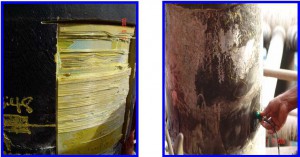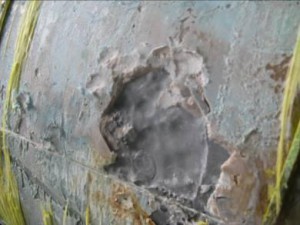March 2011, Vol. 238 No. 3
Features
Long-term Durability Of Clock Spring Repairs - Recent Removals And Examinations
The Clock Spring repair system was the subject of a rigorous research and development program conducted under the management of the Gas Research Institute (GRI, now known as GTI). The program extended over a decade and considered long-term degradation.
Special sections of the program specifically investigated the cathodic disbondment and cathodic shielding effects, as these were considered to be potentially deleterious to the integrity of the repair and, by extension, to pipeline safety.
An extensive field validation program was required by the U.S. Department of Transportation. This requirement was added to verify the laboratory experimental results and to provide real-world behavior validation on actual pipelines. A statistically significant sampling was required and a matrix of various soil types, location and environmental condition was created as the basis for the field validation study. The results were published in the public report GRI 1998-0032. This peer-reviewed report was relied upon by the industry and regulators as the basis of documentation to suggest amended code language for both liquid and natural gas pipelines which was subsequently proposed and adopted in CFR 192 and 195.
These various GRI reports, and specifically this field validation study report, have often been cited in technical literature discussing various aspects of the composite repair of pipelines. While this body of technical information is widely considered to be extraordinarily valuable to the industry, these reports cover only one potential architecture and one set of constituent components. Not all potential technologies will produce similar results. In fact, several architectures and components were examined and excluded during the GRI program, as unlikely to be able to provide the durability required to be regarded as permanent.
Various components and architectures are commercially offered as composite wraps. Comprehensive field validation studies of these various wraps are not readily identified. While current language within ASME B31-8S and other similar codes does recognize a “composite sleeve” as a permanent repair for various types of defects, “composite wraps” do not currently share this recognition. Recently, reports of poor performance of several variations of “composite wraps” has led some industry practitioners and regulators to question the technologies involved.
Over two decades have passed since the GRI established the first steering committee of industry experts to design the scope and methods of the investigations. Several hundred thousand Clock Spring repairs have been made. Units have been installed in scores of countries and in almost all conceivable environmental conditions. It seems appropriate to document the few repairs that have been taken out of service, and investigate these for condition and efficacy of repair effectiveness.
Recent Removals And Examinations
Commercial sales of Clock Spring commenced in the early 1990s (with some repairs made prior to this date and done under GRI research and development programs). Hundreds of thousands of repairs have been made. The cumulative years of coil service has passed 1 million. The data base of installed repairs in large.
Only occasionally does a prudent operator remove a permanent repair from service. Several specific repairs, on various types of defects, various grades and diameters of pipe and in various geographical services, are presented here.
Case 1: North American Natural Gas Pipeline: 30-inch diameter.
Repair at a girth weld. Moist and warm environment. Pipeline subjected to alternating wet and dry conditions.
Repairs were made in 2005. A subsequent ILI inspection indicated that the potential for metal loss existed beyond that which existed prior to the repair. The concern was raised that corrosion under the repair was active. The operator investigated. The repair was removed in 2010 as part of a continuous improvement program under their IMP program.
Conclusions: Units were well installed and were very difficult to remove. All units were well- bonded to the carrier pipe and each layer within the repair coil was well-bonded. No new corrosion under the repair was identified.
Case 2: North American Liquid Pipeline: 18-inch diameter.
Subsequent to an ILI run, five coils were installed in 1999, all on one joint of pipe. In 2003 the line was selected for an ILI investigation which utilized newer technology and promised a higher level of resolution than that which was utilized prior to 1999. The operator decided to remove the joint of pipe and investigate.
(caption)
Figure 2: Photograph of the removal.
Conclusions: The repairs were effective in all regards. No active corrosion. All repairs well- bonded to the pipe. The repairs were fully functionally and effective.
Case 3: North American Liquid Pipeline. 30-inch diameter. Tape coating on the carrier pipe. Northern climate. The line has a history of SCC.
A single Clock Spring coil was installed in 1995. The unit was removed in 2010 after 15 years of service.
![]()

Figure 3: Two photographs of the removal.
Conclusions: The unit had to be sandblasted and pry bars used to remove the various layers of the coil. The coil was well-bonded within each layer and to the carrier pipe. No evidence of any active corrosion. No evidence of any cathodic disbondment or cathodic shielding effects. After 15 years of service the repair remained sound and durable.
Case 4: Asian Oil pipeline.
A repair of a rather significant dent. The repair was made in 2006. The climate is very tropical, hot and humid with significant moisture present in various times of the year. The unit was selected to be removed to better enable the passage of future pigs.

Figure 4: Two photographs of the removal.
Conclusions: The dent was well-restrained. No evidence of any integrity threat. The coil had to be removed with significant force required to dislodge the coil. The repair was 100% effective. No degradation was observed.
Case 5: Middle East Offshore oil production riser. 18-inch pipe, vertical installation.
A corrosion investigation located an area of extensive metal loss. This metal loss was externally measured as 56% of the wall thickness at the time of repair installation in 1997. In 2006 the riser was selected for a shutdown; in connection with this, the repair was selected to be removed to verify all prior information regarding the permanent nature of Clock Spring repairs. A grinder had to be utilized to completely remove the coil and the filler material for the carrier pipe.
Conclusions: The repair was well-bonded to the pipe. The repair was very difficult and time-consuming to remove. After nine years of offshore marine service, in a hot and humid environment, the metal loss was measured to be the same 56% identified at the time of the original repair. The repair was sound, no concerns were identified.

Figures 5: Two photographs of the removal.
Case 6: North American Gas Pipeline: 30-inch. Repairs made in 1996.
A low-resolution MFL ILI run was made in the mid 1990s. Three Clock Spring coils which were manufactured on Jan. 28, 1996 were used to repair the pipeline segment. A subsequent high-resolution MFL ILI run was done in 2008. This report indicated metal loss that was greater than reported on the low resolution run from the mid 1990s. The operator decided to remove a segment and investigate.

Figure 6: Photograph of the removal.
Conclusions: The pipeline segment was sent to an indoor facility for investigation. The three Clock Spring coils required 5.5 hours to remove. Each coil was well-bonded. No active corrosion, no disbondment, no evidence of cathodic shielding. The repair was sound and fully functioning.
Consistent Findings
The U.S. DOT required that GRI conduct a field validation study to verify the laboratory findings that a Clock Spring was a permanent repair and was at least no less safe than traditional repair methods (it can be argued a Clock Spring repair maximizes worker safety, public safety and pipeline integrity due to the elimination of risks associated with heavy equipment, hot work and welding-related concerns). This field validation study considered units which had been in service for periods of 2-7 years. The cases reported above considered units that had been in service for periods as long as 15 years. The installed base of units is large.
The findings are consistent. A properly designed and installed Clock Spring is a repair which permanently restores the serviceability of the pipe. This has been proven and validated by reliable engineering data and analysis. The GRI and the U.S. DOT made sound technical decisions regarding these issues. The operational history of these repairs supports these decisions and validates the engineering data and design.
The architecture utilized and the constituent components selected provide the durability required to achieve permanent and safe pipeline repairs.
Author
Shawn M. Laughlin is president and CEO of the Clock Spring Company, L.P. He has served in those roles since March 1998 and he has extensive experience in the welding industry with specific expertise in pipeline and energy infrastructure markets having worked in the U.S., Former Soviet Union and Asia for The Lincoln Electric Company. He is a past chairman of the Connecticut Section of the America Welding Institute and has served as a member of the board of the Interstate Natural Gas Association of America Foundation since 1998. He holds a B.S. degree in chemical engineering from Cornell University and a MBA degree with concentrations in international business and finance from the University of Connecticut.





Comments